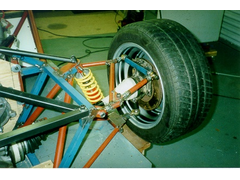
IRS uprights
Nisseven - 31/5/06 at 10:55 AM
Hi,
At some stage I have to design and build an IRS for my car. I have searched the site but did not really find the answer to my question. What are the
pro's & con's of having the single joint at the bottom and the double joint at the top as opposed to the normal way of the opposite. It
would seem to make the mounting of the shock easier as it could be in the centre of the two joints and mounted to the upright.
I can think of a disadvantage but would like to hear some of your views on the subject before I prejudge mine.
Bruce Kelly
Bob C - 31/5/06 at 11:21 AM
if you think of the wheel as a lever - whatever force the contact patch generates( corner/accelerate/ linear brake) there is about 2x the stress on
the bottom pivot compared to the top.
so 2 at bottom & 1 at top means same size joints everywhere ;^)
Bob
Fred W B - 31/5/06 at 11:33 AM
I started out like that, with two at the top, but if you try to get the mounting points as far away from each other as possible, within the
constraints of the wheel rim, you end up with the lower joint, and therefore wishbone very close to the ground, and keeping the wishbone flat then
determines the lowest chassis point, IE no ground clearance under the chassis.
It was also tricky to get the shock to clear the driveshaft and the top wishbone, so I eventually went with the single at the top. You usually find
their is a reason everyone does it the same way!
Cheers
Fred W B


Rear Suspension mock up
[Edited on 31/5/06 by Fred W B]
Nisseven - 1/6/06 at 11:28 AM
Hi Fred,
Thanks for your reply. I've seen some of your work on a recent post and thought it looked pretty good. Those were the sorts of concerns that I
imagined. As I am building a seven the shock can come of the top and is located under the rear frame. I think that i will draw it up and see how it
might work as it is similar to the silvia rear suspension on my donor. There is a decent sized ball joint on the bottom (14mm thread) which is exactly
the same as the bottom of the front upright. I can reuse this. The actual rear upright is useless as it has really weird geometry.
Bruce


